Claussen Pickles are kosher dill pickles at their crunchiest, saltiest best! These homemade Claussen pickles taste like the commercial ones you find at the store, but better. And better yet, they’re ridiculously easy to make!
Whether you’re new to pickle making or a pickle veteran, you NEED to make these half sour pickles! And wonder of wonders, you don’t need to know how to can to make these super fresh, crunchy pickles! Claussen dill pickles are meant to be eaten fresh.
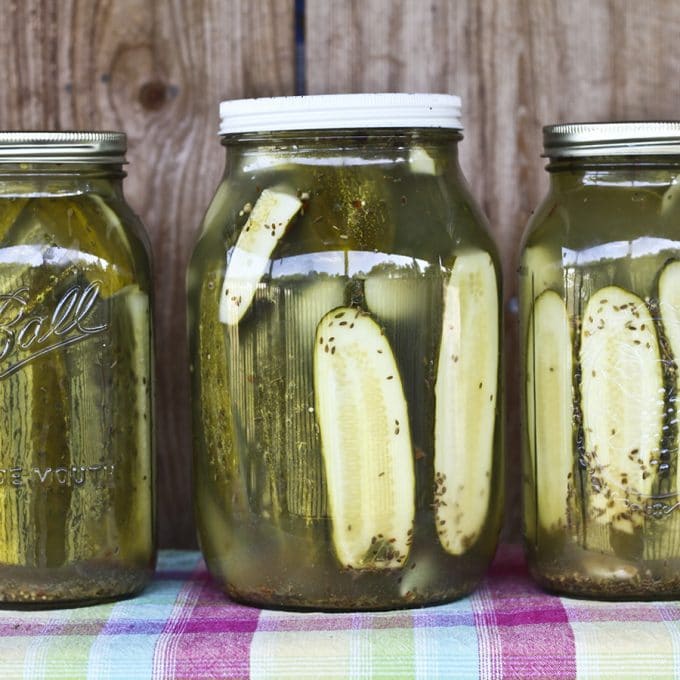
Homemade Claussen Knock-Off Pickles: Always crunchy and garlicky, this perfect homemade pickle recipe requires no special equipment, & no canning experience.
It’s common knowledge that I have a salty tooth rather than a sweet tooth. When the weather does what it has been doing lately (making us all do our best Shadrach, Meshach and Abednego impersonations) I can’t think of a single thing I find more refreshing than an icy-cold, salty, crunchy pickle.
It’s not just me, it’s my whole family: mother, sisters, brothers, cousins, aunts, grandparents, kids, husband… I married a man who loves pickles so much he eats the pickles and then drinks the juice from the jar.
I grew up eating my Grandma’s homemade dill pickles like the supply was endless and moved on to canning my own pickles as soon as I had a kitchen of my own. There’s just something about a homemade dill pickle that makes me happier than any pickled cucumber ever should.
My little sister, Jessamine, and I compare our homemade pickles from year to year the way some people compare wine vintages.
Dill Pickle Recipe
But there is one pickle that stands head-and-shoulders (were pickles to *have* heads and shoulders) above all others. I’m talking about the pickles you see here. That’s right: Homemade Claussen Dill Pickles.
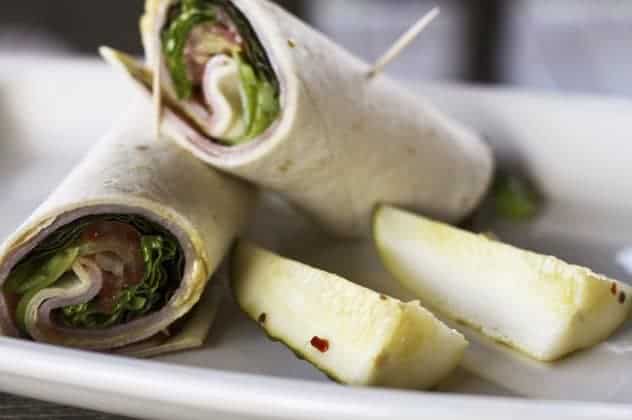
Recipe for Claussen Pickles
What do you need in order to make this recipe for Claussen Half Sour Pickles at home? Let’s get a quick list for both ingredients and equipment out of the way, shall we?
Equipment for Making Claussen Pickles at Home
- A Glass gallon jar or 4 glass quart jars or other food safe container with a tight fitting lid
- Measuring cup
- Chef’s knife or paring knife
Ingredients for Making Homemade Claussen Pickles Copycat
- Small to medium size pickling cucumbers (check your local farm stand or farmer’s market!)
- Apple Cider Vinegar (don’t fret- it doesn’t taste like apple cider and isn’t even a little sweet!) or white vinegar
- Kosher Salt
- Garlic
- Dill (either fresh or dill seed)
- Pickling spices (available here)
A quite note on your vinegar choice: I opt for apple cider vinegar because it’s a smoother vinegar than white vinegar. It does not impart any sweetness or apple taste to the pickles whatsoever.
If you can’t find it (pssst. It’s right next to white vinegar in even moderately stocked grocery stores) or don’t feel like buying it, you can most certainly substitute white vinegar. It’ll just taste a little sharper. (And technically store bought Claussen pickles have white vinegar, so you do you!)
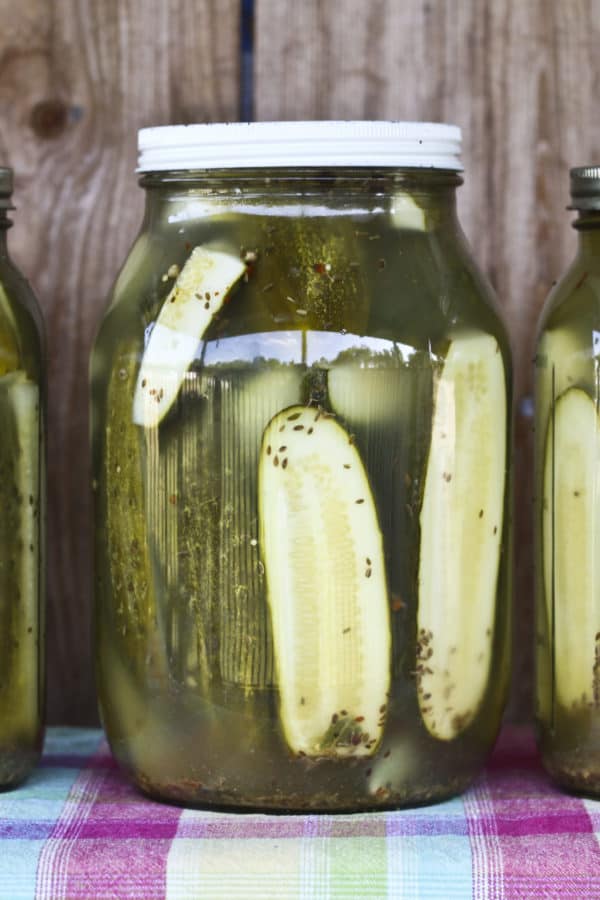
And ya’ll. These homemade half sour pickles are so easy to make it’s almost criminal.
The hardest part is the 2 to 4 day wait for them to be done. Truth be told, though, I’ve snacked on them the day after I made them and been a very happy camper.
Claussen Pickle Recipe
These are homemade refrigerated deli pickles, also known as Lithuanian half-sours, also known (in the commercial equivalent) as Claussen dill kosher pickles, also known as the best pickles ever known to mankind.
Here’s the thing. While I do love my other homemade pickles dearly (otherwise why would I continue canning ninety-something quarts year after year after year), these are by far my all-time favourites.
CRUNCH. That’s what you hear when you bite these. There is no flop, no squish, no soft pickles. These things almost bite back.
This also happens to be the perfect dill pickle recipe for beginning pickle makers. If you’re not into canning, these refrigerator pickles are a godsend. Even if you ARE canning obsessed, like yours truly, this Claussen pickle recipe should be in your pickle repertoire too.
Please note that this Claussen pickle recipe is not suitable for canning. The brine is fermented and not very acidic, which means it has far too high a PH to can safely. If you’re looking for a great canned dill pickle recipe, try this home canned garlic dill pickle recipe.
Refrigerator Pickles
Here’s where we get into the best part of this pickle recipe (aside from the crunch and flavor). You don’t have to cook anything to make these pickles; not one single thing. The brine is stirred together, the cucumbers are rinsed, trimmed and stuffed into a jar with garlic cloves and spices.
These half sour pickles are NOT CANNED. They are simply put into jars. Amen!
When it’s summer time and the idea of turning on the stove makes me want to crawl into an (air conditioned) hole, these pickles are a welcome treat. Not only is that cold crunchy refrigerator pickle waiting to cool me off at the end of the prep time, but I don’t have to heat up my kitchen by even one single degree to get there.
Remember that pickling isn’t just for cucumbers, either! Try out our Pickled Brussels Sprouts, Quick Pickled Red Onions, and famous Candied Jalapenos!
How to Make Pickles FAQ
Please, please, please give these a go even if you have never made a pickle before. There is nothing scary or intimidating here. Wash, slice, stuff, stir, pour, sit, wait.
- Trim 1/8-inch from the blossom end of each cucumber and slice them in half lengthwise or into quarters. The size you choose depends on how large your cucumbers are and how big you want the pickles to be when they’re done. This helps minimize the chances of soft pickles.
- In a gallon jar (or large, wide-mouth, food-safe container) layer the dill heads or seed, pickling spice or mustard seed, and garlic cloves and sliced cucumbers. If you’re dividing the cucumbers up between smaller containers, just divide the garlic and spices evenly between the containers, too.
- Stir your brine together in a separate container. You WILL have more brine than you have space for in the jars, but that’s why you pack the spices in the jars. Just store extra brine in a jar in the refrigerator and use it to top off your pickles if the brine starts evaporating.
- Pour the brine over the cucumbers, taking care to make sure all of them are fully submerged. If needed, place a plate or mug or other ziploc bagged can of beans on the cucumbers to weigh them down and keep them under the brine!
- Cover the jars lightly not tightly and leave out of direct sunlight on the counter for two to four days or until the pickles are picklicious.
- If your kitchen is pretty hot or humid, you can stash them directly in the refrigerator. They’ll just take a couple of days longer to get fabulous. Your patience will be rewarded.
On the plus side, the wait is only two to four days which is significantly less than the six week wait of the canned pickles. Besides, as I said, there is the crunch factor
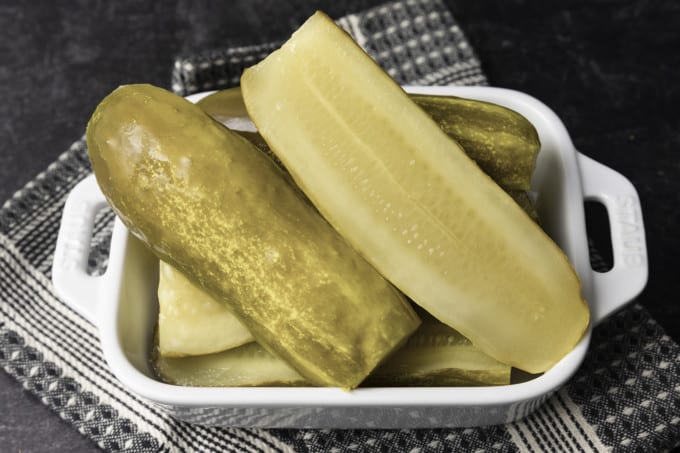
Troubleshooting Your Homemade Claussen Pickles
These pickles are easy peasy to make, but there still may be a couple of things that pop up from time to time that make you go “Hmmm…” In no particular order, here are some of the most commonly asked questions about them and some answers!
- Why is my pickle brine cloudy? Okay, I lied. This is the most common question and that’s because the brine becomes cloudy naturally as a consequence of fermentation (which is what’s happening here.) No worries.
It’s all natural. This half sour pickle recipe (more on this to come) is a fermented pickle recipe and that just happens.
Another possible cause of intense cloudiness or discolouration in your brine is using table salt. The iodine in table salt can also give off flavours to your pickles, so it’s best to stick with kosher salt or pickling salt for these bad boys! - Is the scum, foam, or film on top of my pickle brine dangerous? It’s that pesky (and delicious) fermentation again! This is another thing you don’t have to worry about.
Just scrape it off with a spoon, discard, and top off with a little of that extra brine you whipped up. (See the recipe card for details.) But do remove the scum or it could cause your pickles to go bad. - My pickles went soft! How do I prevent this? This particular tragedy could have two causes.
First, you may have failed to remove enough of the blossom end of the cucumber. There is a naturally occurring enzyme in the blossom end of cucumbers that causes pickles to break down and become soft if it is not removed. Next time, just slice more off.
Second, you may have started with less than spectacularly fresh cucumbers. An older cucumber has had longer for the aforementioned enzyme to kick in, and it has already started its work.
The best solution for this issue is to use cucumbers that have either been picked fresh that day or have been refrigerated steadily since very shortly after being picked a couple of days previously. - Why did my pickles go bad? See that second reason in the “why did my pickles go soft” bullet point? That’s one culprit.
Other potential causes of spoiled pickles are using unwashed cucumbers or fresh dill, old or decayed garlic, bad spices, lower-than-5%-acidity-vinegar, failing to remove the scum from the brine or to keep the pickles submerged in the brine, or storing your pickles in warmer conditions. When in doubt, stash them in the refrigerator! - Why is there mold on my pickles? First, you have my condolences. Second, it’s because your pickles didn’t stay submerged in the brine. That brine has enough salt and acid to prevent mold growth if the cucumbers stay under the surface.
If you’re having trouble finding something that fits in the jar to keep this from happening, try popping a can or two of tomato paste or canned beans in a zipper top bag and gently inserting that into the jar. It should weigh it down enough to do the job. - Should I worry about the white sediment in my jar? This is another one in the “don’t sweat it” category. There are two potential reasons and both are completely harmless.
It’s either a natural consequence of the fermentation or anti-caking agents in the salt. Neither harms the pickles or effects the flavour, so don’t worry! - Why is my garlic blue/green/purple? As long you inspect the garlic before it goes into your jars and it is fresh as a daisy, you have nothing to worry about. It could be the type of salt you used or it could be the variety of garlic. Some types of garlic have a natural propensity to change pretty colours in vinegar.
It also may mean that your pickles were exposed to light. When garlic is exposed to light, it starts producing chlorophyll which is green. It also may indicate that your garlic is more mature.
In that case it is caused by sulfur compounds that naturally occur in more mature garlic reacting with minute traces of copper in the vinegar., but as long as there are no other signs of spoilage (soft or squishy texture, funky smell, discoloured spots), you’re good to go.
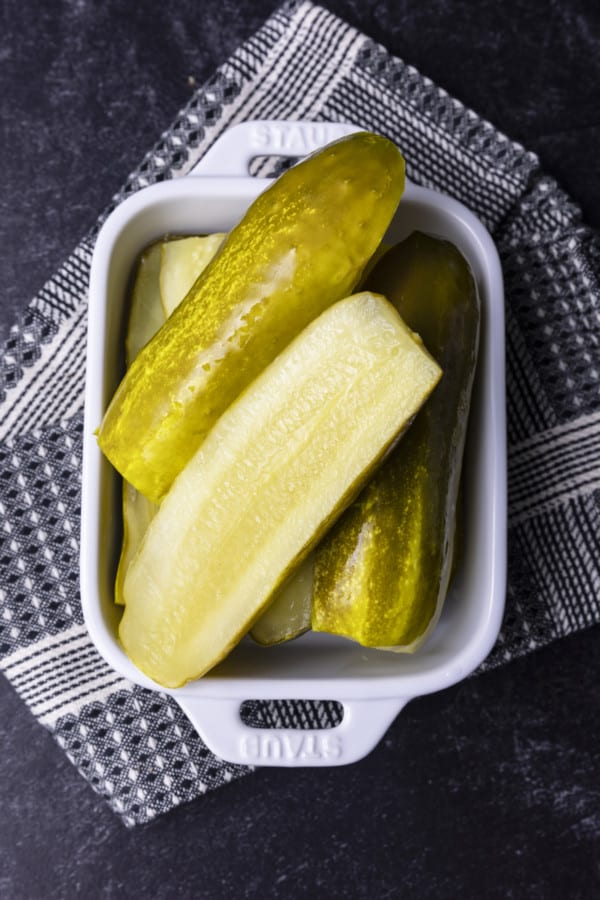
IMPORTANT NOTE: Because there is so much diversity in temperature, humidity, age of cucumbers, etc… involved in this recipe, please check your half sour pickles starting at 24 hours for doneness. If the pickles smell/taste pickley, move them to the refrigerator. Do not keep them on the counter longer than 4 days.
ANOTHER IMPORTANT NOTE: These pickles are not suitable for canning. They’re simply not acidic enough to can safely, and that is in addition to the fact that you’d ruin that perfectly crisp texture by introducing heat to the party.
What can I serve with these Homemade Claussen Knock-Off Pickles?
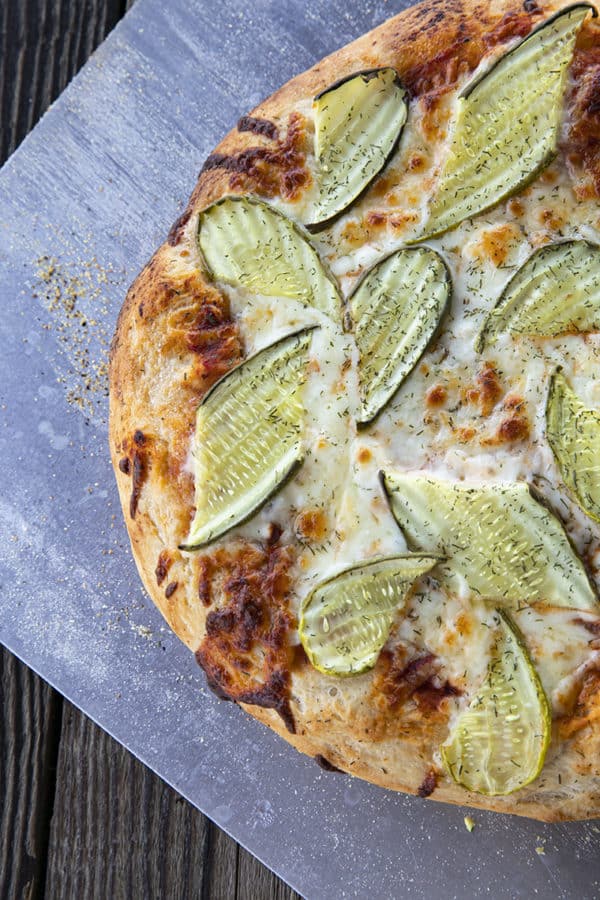
Start out by trying your half sour pickles in this Pickle de Gallo, Dill Pickle Dip, Dill Pickle Egg Salad, or Bagel Burgers with Dill Pickle Cream Cheese.
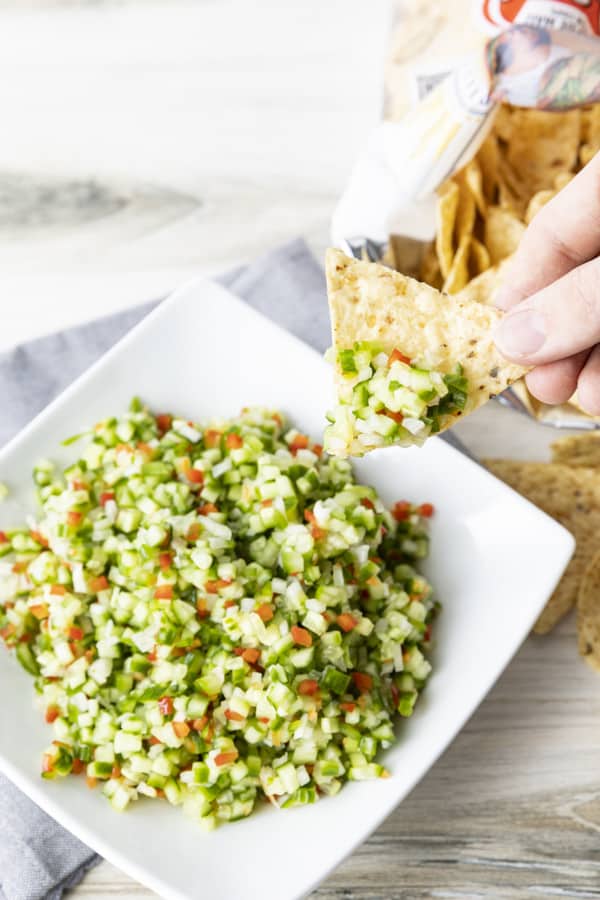
Even better, serve them on our Cheeseburger Salad or Pickle Pizza.
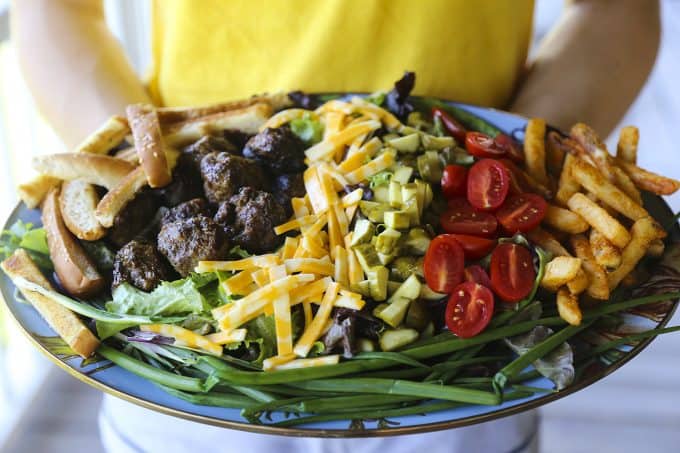
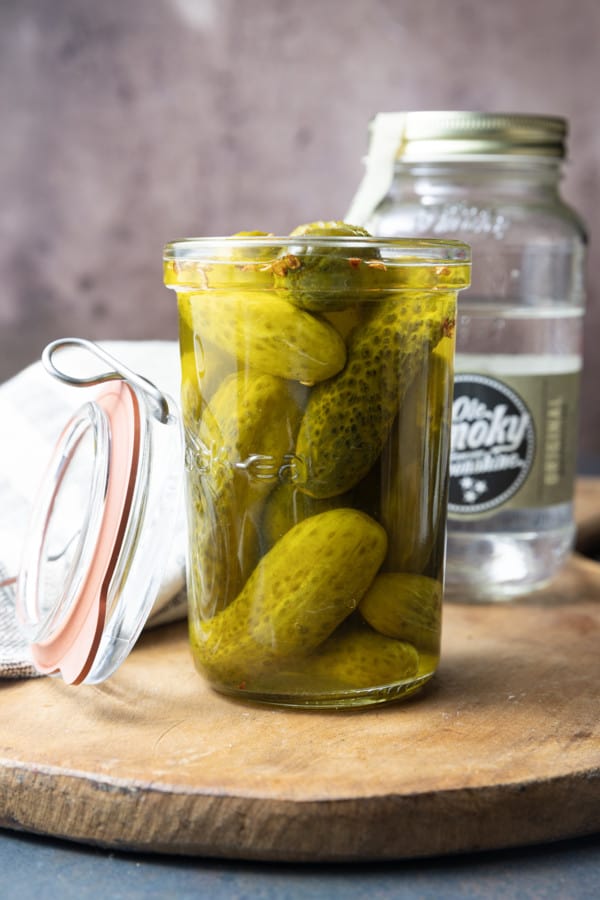
You can even take extra pickles (like that’s a thing!) and make these divine Moonshine Pickles. You’ve never had a better Bloody Mary than one made with homemade Moonshine Pickles!
Half Sour Pickle Recipe
What makes Claussen PIckles different from canned pickles? Claussen pickles, whether homemade or store bought, are a half sour pickle recipe.
That means they’re fermented instead of heat processed. That’s what gives them such great texture.
This half sour pickle recipe yields pickles that are crunchy to the point of making noise when you bite them, cold, and seriously garlicky. Canned, shelf-stable pickles can be chilled, maintain some crunch, and be as garlicky as you want them to be, but they are never, ever going to be the same thing because of science.
When you heat process a jar of pickles you are, in actuality, cooking it and a cooked pickle just plain can’t be as crunchy as an un-cooked half sour pickle recipe.
These homemade pickles keep well in the fridge for about six months, as long as they remain submerged in the brine. In our house, they never last that long because, as the saying goes, “A pickle a day keeps sad times away.”
They say that right? Someone must. If not, I’m going to start. It’s true, after all.
Claussen Pickles
Wash cucumbers but do not scrub them.
Trim 1/8-inch to 1/4-inch from the blossom end of each cucumber and slice in half lengthwise or into quarters, depending on how large your cucumbers are and how big you want them to be when they’re done.
Layer the dill heads or seed, garlic cloves, pickling spices and sliced cucumbers in a gallon jar (or large, wide-mouth, food-safe container). You can evenly divide the dill, garlic cloves, pickling spices, and cucumbers between several smaller jars if needed.
In a separate pitcher or bowl, stir together the remaining ingredients until the salt is dissolved.
Pour the brine over the cucumbers, taking care to make sure all of them are fully submerged. If needed, place a plate or mug or other non-reactive heavy item on the cucumbers to weigh them down and keep them under the brine!
Cover lightly with a lid just perched on top or secure a piece of cheesecloth over the jar with a rubber band to keep fruit flies away. Store any extra brine in a covered jar or pitcher in the refrigerator and use it to top off the brine if it starts to evaporate and expose the pickles to the air.
Leave out of direct sunlight on the counter for at least 24 hours, but up to 4 days, or until the cucumbers taste like pickles throughout.
Fix your lid onto your jar or container and chill thoroughly. These can be stored in the refrigerator for up to six months provided you keep them covered with brine.
NOTE: If at any point in the proceedings “fuzz” or “foam” develops on top of the brine, use a spoon to remove it. If there is “fuzz” attached to any of the cucumbers, remove the ones affected and be sure the others are still fully submerged.
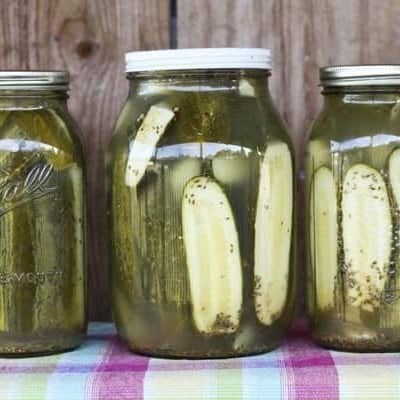
Homemade Claussen Knock-Off Pickles
Equipment
- 1 gallon jar or 4 quart jars or a large, food-safe container with a tight fitting lid
- 1 liquid measuring cup
- 1 large mixing bowl or pitcher
Ingredients
- 35 to 40 small to medium pickling cucumbers
- 1 gallon cold water
- 1 cup apple cider vinegar, preferably raw or white distilled vinegar
- 2/3 cup coarse canning or kosher salt Do NOT fine or use iodized salt!
- 4 cloves garlic or more to taste
- 4 heads fresh dill or 4 tablespoons dried dill seed not weed!
- 2 tablespoons mixed pickling spices
Instructions
- Wash cucumbers but do not scrub them.
- Trim 1/8-inch from the blossom end of each cucumber and slice in half lengthwise or into quarters, depending on how large your cucumbers are and how big you want them to be when they’re done.
- In a gallon jar (or large, wide-mouth, food-safe container) layer the dill heads or seed, garlic cloves, pickling spices and sliced cucumbers.
- In a separate pitcher or bowl, stir together the remaining ingredients until the salt is dissolved.
- Pour the brine over the cucumbers, taking care to make sure all of them are fully submerged. If needed, place a plate or mug or other non-reactive heavy item on the cucumbers to weigh them down and keep them under the brine!
- Cover lightly with a lid just perched on top or secure a piece of cheesecloth over the jar with a rubber band to keep fruit flies away.
- Leave out of direct sunlight on the counter for two to four days*, or until the cucumbers taste like pickles throughout.
- Fix your lid onto your jar or container and chill. These can be stored in the refrigerator for up to six months provided you keep them covered with brine.
- *If at any point in the proceedings “fuzz” or “foam” develops on top of the brine, use a spoon to remove it. If there is “fuzz” attached to any of the cucumbers, remove the ones affected and be sure the others are still fully submerged.
Notes
Nutrition
Nutritional information is an estimate and provided to you as a courtesy. You should calculate the nutritional information with the actual ingredients used in your recipe using your preferred nutrition calculator.
did you make this recipe?
Make sure to tag @foodiewithfam on Instagram and #hashtag it #foodiewithfamily so I can check it out!
Originally published July 22, 2011. Updated with FAQs and Troubleshooting and reposted August 2022.
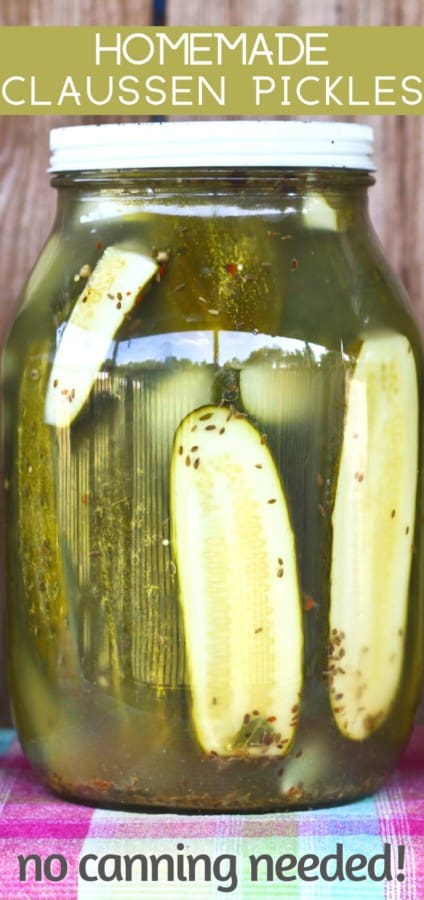
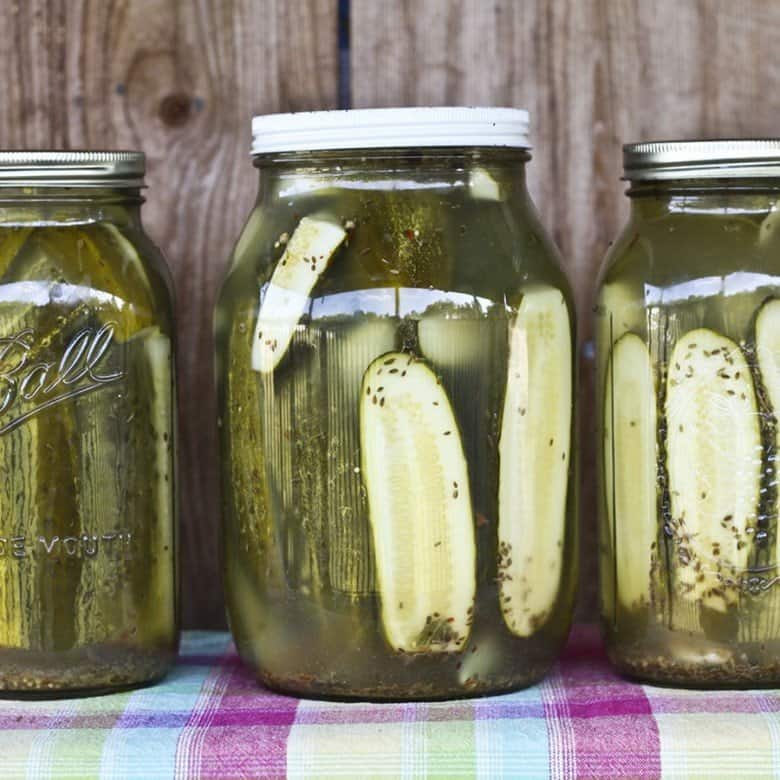
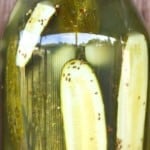



Reader's Thoughts...
Frank Long says
I see the Claussen pickles use distilled vinegar. Should I use apple cider vinegar?
Rebecca says
I love to use apple cider vinegar when I am fermenting pickles because I prefer the flavour of it. Claussen also adds sweetener to their brine which I do not do.
IFortuna says
It wasn’t until much later in life that I developed a craving for pickles and pickle juice. I love it no mater the season and now I just pour myself a small glass anytime of day.
I use Bragg’s apple cider vinegar when the jar gets low in juice and the mother in the vinegar cultures it a bit and gives it a little fizz. Delicious!
Sorry, I only eat Vlasic pickles. They are the most crisp and delicious in my opinion.
Sometimes, I make my own Japanese pickles in a Japanese pickle press. They are, of course, delicious with any type of Japanese meal, sushi, tempura and even Japanese curry.
I may try this recipe, however, at some time. Thanks for posting it.
Rebecca says
I love the idea of stretching the pickle juice with Bragg’s!
Crystal says
Quick tip for anyone making them in regular mough mason jars- 2 or 3 toothpicks inserted long ways underneath the neck of the jar holds them under the brine just wonderfully!
I have had mine on the counter for 3 days and just can’t help myself anymore..
Ive snuck one or ten out at this point and boy are they good!! ?
Rebecca says
That is a fantastic pointer, Crystal! Thank you!
Chris says
This is cool. Thanks for posting this. Do you know if it is okay to use less salt for a low sodium version? Thanks.
Chris says
Never mind, I just found someone else’s previous post about salt. 🙂
Betty says
I found these to be incredibly good. The cloudy brine kinda puts me off, but there was no slime or mold, and the pickles taste good. Going to make another batch already. They’re kind of addicting! I’m going to try adding a bit of horseradish to a jar this time. I’m used to canning pickles in a boiling water bath, but this is much easier. Thanks!
Nate says
I just wanted to say how impressed I am at your dedication to this comment trail. 4 years of reply to the same questions without the slightest hint of frustration is admirable. Keep up the strong work and I look forward to my pickles.?
Ali says
Hello! I tried out your recipe and the pickle brine has become cloudy. I have them in the fridge now but wanted to know if that is normal. The liquid is not clear like other pickles. Is this ok?
Rebecca says
That’s fine and dandy! As long as the top doesn’t grow fur or start sassing you like a teenager, cloudy is good in these quick-ferment pickles. It means it has fermented!
Laura says
How can i can these without cooking them. I want them crispy and not cooked. Help
Rebecca says
Hi Laura- These are not suitable for canning. These are fresh pickles, so you’ll want to store them in the refrigerator rather than canning them!
Carol says
I have my first batch of these pickles down right now; I have used regular cucumbers instead of the pickling ones and noticed this morning when I checked them after 24 hrs. that the cucumbers feel limp at this point. I am assuming that that will change as they bathe in the mixture. I also used fresh dill, lots of it, from my herb patch and lots of garlic! I make pickles a lot but have never tried these and Claussen are my favorites! Thanks for posting and I can’t wait to see how these turn out.
Rebecca says
Hi Carol- I hope they crisp up for you. Regular cucumbers definitely don’t hold up as well texturally to the pickling process as the little picklers, but the flavour should still be good!
Kathy Huskey says
Can you cut cucumbers in chucks??
Rebecca says
I have not tried that! Let me know if you do!
Sarah S says
Does this recipe work well for whole pickles, rather than halved or quartered? I LOVE whole pickles!
Rebecca says
You betcha! As long as they’re not, well, femur sized… You want to use more petite whole cukes if you’re going for the whole pickle effect.
Carly says
Can you define ‘room temp’? Also, does the size (diameter) of the cucumber alter the amount of time to leave things on the counter? My pickling cukes are starting to come in and they’re a pretty broad range of sizes – pinky size all the way up to ridiculous (because they were hiding). I want to experiment with your recipe before the heavy production gets here. 🙂
Rebecca says
Room temp is generally considered 65-75 degrees. I would say to keep the cuke size uniform, but beyond that, perhaps just not the femur sized cukes 😀
Carly says
Thanks for the size and temp clarification! We’re heading into day 3 of the process and (knock wood) so far, so good. New question though: Once these are placed in jars and put in the fridge for long-term storage, how does one keep them 100% under the brine? I am predicting that these things are going to want to float. Correct? If so, what’s the solution for keeping them submerged?
Rebecca says
They do have a tendency to float, Carly. I usually pop a saucer in the jar upside down and that little bit of weight does the job.
Brian Mann says
Hello. I made batch of these on Sunday. Waiting rather impatiently for the four day window to end. I only had a few pickling cukes, and not a large enough container to make a full batch of brine. So I cut the brine recipe in half, and yielded two quart jars of pickles.
I have a couple of questions. I did pour leftover brine into a clean, empty quart jar, then refridgerated. It is very tasty by the way. I have been sipping on it daily. My first question is this…the leftover brine tastes more salty than the brine with the cukes. Not too salty for my tastes because I love salt. But I was wondering if that is normal for the taste difference to be present.
My second question…I have been watching my jars daily during the fermentation process, and I have not seen any fuss or mold on the cukes nor on top of the brine. Did I do something wrong, or is this just a bit of good luck?
Thank you for sharing this recipe. From what I have tasted so far, I think they will be fantastic once chilled thoroughly!
Charm Monroe says
I tried this recipe, my family loves them. So easy to make.
Rebecca says
I am so glad! 😀
Eric says
Do you have to leave these out on the counter or can they just go into the refrigerator right away. I understand they may take a little longer to marinate this way. Any thoughts?
Rebecca says
Hi Eric- If you flip through the comments you may find a few folks who have done that. I have not personally tried it, so I can’t speak to it from experience. I prefer just to use the room temperature approach.
davey says
Bon Appetit has a recipe for lacto-fermented dill pickles (saltwater brine, no vinegar) that are immediately put into the fridge for 10 days. They aren’t left out on the counter at all. The colder temperature will retard fermentation, but it will still happen over a longer period of time. Bon Appetit calls them half-sours.
Lindsey says
I have heard that if you use water for the pickles instead of vinegar, it will be better for probiotics. So can you leave the vinegar out or if you do it won’t make it a Claussen?
Rebecca says
Hi Lindsey- Claussen uses vinegar, and this recipe is designed specifically to be made with vinegar. I have had half sour fermented pickles, but this recipe was geared for making with vinegar, so I’d advise you to use one that was specifically designed to make with water if you want to try it! 😀
andrew says
It’s also worth noting that Claussen pickles are not fermented, they’re pickled. I know it sounds weird, but the best way to describe the difference between the two is that fermented vegetables are made with a salty brine and the sour flavor comes from natural production of acid during the fermentation process which will also be high in probiotics. In the pickling method, an acidic brine is used (typically by the addition of vinegar) and the brine imparts the sour flavor on whatever is soaking in it. This method will be lower in probiotics because vinegar inhibits the fermentation process and therefore the good bacteria does multiply like it does during fermentation.
Donna Brockman says
I love this recipe! But I was wondering if these have to be left out or can they be put in the frig to ferment? I tried a batch and they were fine and smelled divine days 1 & 2, on day 3 they were fuzzy on top so I scraped the fuzz off per your instructions. Day 4 they were even fuzzier and had a foul odor like they were rotten. I threw out the whole batch. I used a glass pickle weight to keep them in the brine and made sure they were on a non sunny spot of my kitchen counter. I do live in Florida, though, so even in March with the A/C on it can get rather warm. I want to try again but this time putting them in the frig, still only covered with cheesecloth. What do you think? I’m thinking it might take longer, though?
Rebecca says
I have not personally tried them in the refrigerator, but I’d say give it a go. If it works, it will definitely take longer. I can’t imagine it could go too far wrong, though. 😀
Barbara says
I seem to be running my family crazy with my love of pickles, they keep telling me I’m going to turn into one, I just can’t get enough! I have one question concerning your recipe as I’m new to pickling. Several recipes I’ve seen say to use bottled water but I noticed yours didn’t, I’m confused.
Rebecca says
Hi Barbara-
I can explain the usual instruction to use bottled water. Many times this instruction is included under the assumption that people are on town/city water and therefore have chlorinated water. Using bottled water (theoretically, anyway) eliminates a variable there. This is true, of course, only if you use bottled water that you’re certain is free of chlorine, which can be a touch tricky. If you use distilled water that is a surefire bet that you won’t have chlorine, but it’s also certain that it will be free of any tasty minerals. As I am on a well, I know fully that my water is safe and chlorine free, so I tend to leave that instruction out. I would say if you’d prefer pickles that you can guarantee are chlorine/fluoride free and you’re on town or city water, you might go for the bottled water. If you’re on a safe well, I’d skip it.
Jason says
Remember when you’re making fermented pickles that the cucumbers must be completely submerged beneath the brine. Otherwise you may get furry bits.
Brianna Danese says
Thank you so much for this amazing recipe! I live in Japan and it’s so difficult for me to get the dill pickles I know and love. Claussen Pickles are my absolute favorite and I always felt like I had to eat as many as possible whenever I visited home. But I tried this recipe last week and I was so happy – a great imitation of Claussen! Would you mind if I linked this recipe (with credit to you of course) in a blog post on my website?